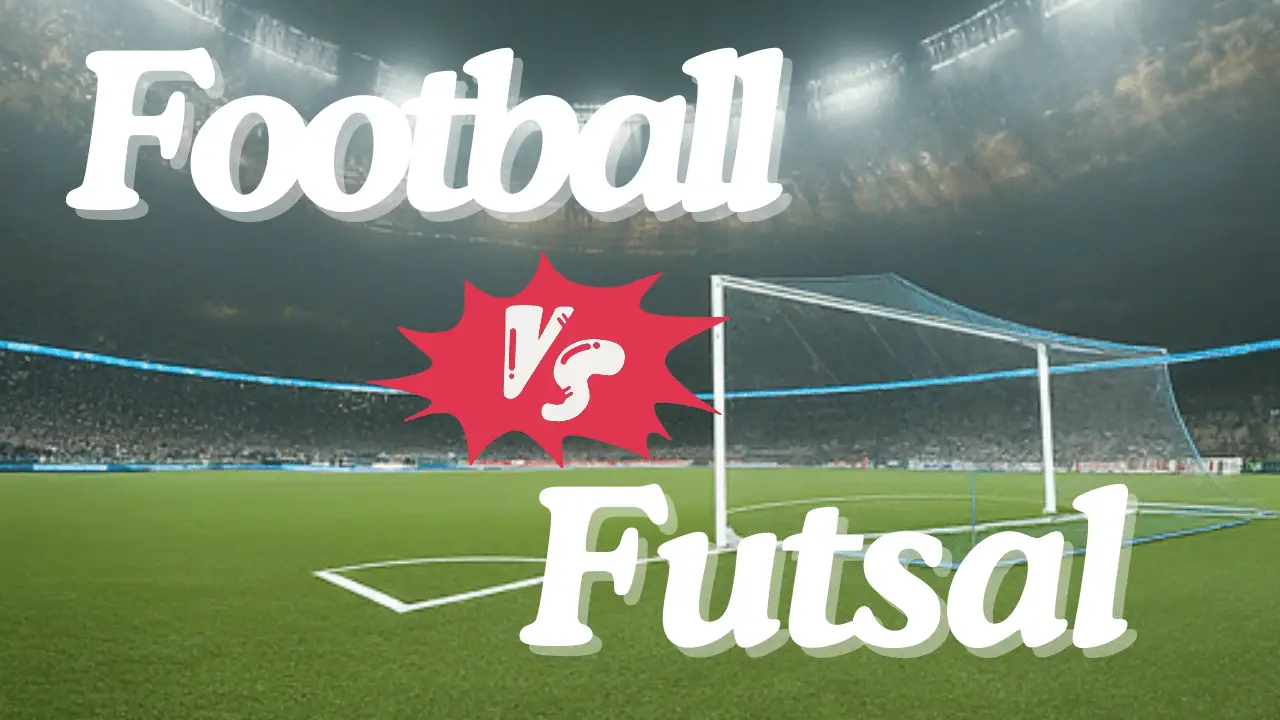Football and futsal are two different versions of soccer. They have their own rules and special features. Both games focus on controlling the ball, scoring, and strategy. But, they have unique details that make them different, offering different experiences.
It’s important for players, coaches, and fans to know these differences. This knowledge helps them enjoy indoor and outdoor soccer more.

Key Takeaways
- Futsal is played with a smaller #4 ball that has 30% less bounce compared to the #5 ball used in soccer.
- Soccer teams have 11 players on the field, while futsal teams have just 5 players, including the goalkeeper.
- Futsal has unlimited “flying” substitutions, while soccer allows only 3 substitutions per game.
- Futsal has a stopped clock with 20-minute halves, while soccer has a running clock with 45-minute halves.
- Futsal does not have an offside rule, unlike soccer, which can lead to a faster-paced, more technical game.
Understanding the Basics of Football and Futsal
Association football and futsal are both beautiful games. But they have different origins, gameplay, and rules. Football started in ancient China, while futsal was created in 1930 by Juan Carlos Ceriani in Uruguay.
Origins and Evolution
Both games involve kicking a ball into the opponent’s goal. But they have evolved differently. Football, also known as soccer, is a global sport run by FIFA. Futsal, an indoor game, has its own World Cup since 1989, run by the AMF.
Core Gameplay Concepts
Football and futsal share key concepts like team play and scoring goals. But their rules and formats differ. This makes futsal a fast-paced indoor soccer alternative.
Global Recognition and Governing Bodies
Football is the world’s most popular sport. But futsal is also loved globally, especially in South America and Europe. FIFA oversees both, ensuring rules are followed and the sport grows worldwide.
| Characteristic | Football | Futsal |
|---|---|---|
| Pitch Size | Larger playing field | Smaller indoor court |
| Team Size | 11 players per team | 5 players per team |
| Substitutions | Maximum of 3 substitutions | Unlimited substitutions (12 per team) |
| Game Duration | 45-minute halves | 20-minute halves |
| Ball Size | Size 5 (68-70 cm circumference, 410-450 grams) | Smaller (62-64 cm circumference, 400-440 grams) |
“Futsal emphasizes offensive play, with more goals scored on average per game compared to football.”
Playing Field Dimensions and Court Specifications
Football and futsal have different playing fields and surfaces. Football fields are 90-110 meters long and 45-90 meters wide. Futsal courts are much smaller, at 38-42 meters long and 20-25 meters wide. This makes futsal games faster and with more player action.
Football is played on grass outdoors, while futsal is indoors on a hard court. The smaller futsal court and hard surface focus on ball control and teamwork. This creates a unique game experience.
| Specification | Football Pitch | Futsal Court |
|---|---|---|
| Length | 90-110 meters | 38-42 meters |
| Width | 45-90 meters | 20-25 meters |
| Surface | Grass (outdoor) | Hard court (indoor) |
| Goal Size | 7.32 meters wide x 2.44 meters high | 3 meters wide x 2 meters high |
The smaller futsal court and goals lead to more goals and a more intense game. This is different from traditional football.
In summary, the field size and surface are key differences between football and futsal. They shape the unique character and gameplay of each sport.
Team Composition and Player Roles
Football and futsal differ in team size and player roles. Football teams have 11 players, with one goalkeeper. Futsal teams have 5 players, with one goalkeeper.
Football Team Structure
Football teams have 11 players, each with a role. There are defenders, midfielders, and forwards. They have specific jobs in defense and offense. Teams can make up to 3 substitutions during a game.
Futsal Team Organization
Futsal teams have 5 players, including a goalkeeper. The team includes a fixo, ala, and pivot. All players must help in both defense and offense because of the smaller field.
Substitution Rules
Substitution rules differ between football and futsal. Football allows up to 3 substitutions per game. Futsal, however, has unlimited “flying” substitutions, where players can switch in and out anytime.
| Football | Futsal |
|---|---|
| 11 players per team, including 1 goalkeeper | 5 players per team, including 1 goalkeeper |
| Defined positions (defenders, midfielders, forwards) | Positions: goalkeeper, fixo, ala, pivot |
| Limited substitutions (maximum 3 per game) | Unlimited “flying” substitutions |
The team size and player roles show the unique challenges of each sport. Players must adjust their skills and strategies for each game.
Ball Specifications and Equipment Requirements
Football and futsal have different ball sizes and weights. Soccer balls are 68-70 cm (27-28 inches) in circumference and weigh 410-450 grams. On the other hand, futsal balls are smaller, measuring 62-64 cm (24.4-25.2 inches) and weighing 400-440 grams.
The futsal ball is a bit heavier than a soccer ball. This makes it easier to control and pass in tight spaces. Futsal balls also have less bounce, perfect for dribbling and passing in small courts.
- Soccer balls have leather or synthetic outer casings. Futsal balls have softer outer layers made of synthetic leather or microfiber.
- Futsal balls are more durable, built to handle hard indoor surfaces.
Players in both sports need to wear the right footwear, shin guards, and sport shirts and shorts. This ensures their safety and comfort on the field.
“The futsal ball is designed to stay on the floor better, allowing for more intricate play.”

Match Duration and Time Management
In football and futsal, how long the game lasts and how teams manage time is key. Both sports are similar but have different rules for the game clock.
Football Time Structure
A football game is split into two 45-minute halves. This makes the total game time 90 minutes. The clock keeps running, except for added time at the end of each half. This extra time is for stoppages like injuries or substitutions.
During the halftime break, players get a 15-minute rest. Then, the second half starts.
Futsal Time Controls
Futsal games have a different setup. Each game is divided into two 20-minute halves, making the total playing time 40 minutes. The clock stops when the ball goes out of play. This ensures the game time is correct.
Teams also get one timeout per half. This gives them a chance to plan and regroup.
The different game duration and clock management affect the pace and strategy in football and futsal.
Scoring Systems and Goal Dimensions
In football and futsal, scoring systems and goal sizes are key. Both sports aim to score goals, but their rules and goal sizes differ. These differences shape the game’s dynamics.
Football goals are 7.32 meters wide and 2.44 meters high. Futsal goals are much smaller, at 3 meters wide and 2 meters high. This size difference affects scoring, with futsal games often having more goals.
The basic rule in both sports is the same: a goal is scored when the ball crosses the goal line. But futsal’s smaller goals and quicker play lead to more goals. This makes the game exciting and unpredictable.
| Sport | Goal Width | Goal Height | Scoring Trends |
|---|---|---|---|
| Football | 7.32 meters (24 feet) | 2.44 meters (8 feet) | Relatively lower scoring rates |
| Futsal | 3 meters (9.8 feet) | 2 meters (6.6 feet) | Typically higher scoring rates |
The unique goal sizes and rules make football and futsal special. Knowing these differences helps fans enjoy the games more. It shows the unique aspects of each sport.
Football vs Futsal: Key Technical Rules
Football and futsal share some basics, but they have big differences in rules and play. Knowing these differences is key for players, coaches, and fans to enjoy each sport fully.
Ball Control and Possession
The ball’s size and weight affect how well players control it. Soccer balls are bigger and heavier, allowing for stronger kicks and longer passes. On the other hand, futsal balls are smaller and lighter, making them better for quick moves in tight spots.
Tackling and Physical Contact
Rules on physical play differ too. In football, shoulder charges and sliding tackles are okay, but not in futsal. Futsal limits physical contact, banning shoulder charges altogether.
Set Pieces and Restarts
Set pieces and restarts are handled differently too. Football uses throw-ins when the ball goes out, while futsal prefers kick-ins. Futsal also has a 4-second rule for all restarts, making the game faster than football.
These differences make football and futsal unique in their own ways. Players must adjust their skills and strategies to excel in each sport. Fans and players alike can appreciate the special qualities of each game by understanding these differences.
Goalkeeper Rules and Restrictions
In football and futsal, goalkeepers have different roles. Each sport has its own rules for them. These rules affect the game’s strategy and flow.
In football, goalkeepers can’t handle the ball if it’s passed back to them. This rule, known as the “back pass rule,” makes the game more exciting. Futsal, however, lets goalkeepers use their hands in their own penalty area. But they can’t throw the ball over the two-thirds line.
Goalkeepers also have different ways to start play after a goal. In football, they kick the ball. In futsal, they throw it. This small difference can change how teams play and the game’s pace.
| Goalkeeper Rules | Football | Futsal |
|---|---|---|
| Back Pass Handling | Not Allowed | Allowed |
| Possession Time | Unlimited | 4 Seconds in Own Half |
| Restart After Goal Clearance | Goal Kick | Throw |
| Handling Restrictions | Within Penalty Area | Within Penalty Area |
Goalkeepers are key in both football and futsal. Their skills in following the rules can make or break their team’s strategy.

Fouls, Cards, and Disciplinary Actions
In football and futsal, keeping the game fair is key. Both use yellow and red cards to handle player misconduct. Futsal also has a blue card for a 2-minute game pause.
Yellow and Red Card Systems
A yellow card is a warning for players. Two yellows mean a red card, and you’re out of the game. In futsal, a blue card gives a 2-minute break, letting a new player in.
Accumulative Fouls
Futsal has a foul count system. Teams can make five fouls per half before they get a penalty kick. This makes players think twice before fouling. Football doesn’t have this system, but players can still get in trouble for misconduct.
| Offense | Football | Futsal |
|---|---|---|
| Cautionable Offenses | 10 offenses leading to a penalty kick | 7 cautionable offenses, including unsporting behavior and dissent |
| Goalkeeper Offenses | No specific offenses listed | 4 offenses leading to an indirect free kick |
| Sending-Off Offenses | Serious foul play, violent conduct, denial of an obvious goal-scoring opportunity, and offensive language | Same as football, plus a substitute can be cautioned for unsporting behavior or dissent |
| Temporary Suspensions | No temporary suspensions | 2-minute temporary suspension with a blue card for player misconduct |
Both football and futsal have strict rules to keep the game fair. This ensures everyone has a good time watching and playing.
Game Tactics and Strategic Differences
Futsal and soccer have different tactics and strategies. Futsal focuses on quick passing and ball control because of its smaller court. Soccer, with its bigger field, uses long-range passes and wider play.
In futsal, players must make fast decisions and move a lot. This is because the game is fast and the court is small. Soccer, with more space, lets teams plan their attacks and defenses more carefully.
| Futsal Strategies | Soccer Strategies |
|---|---|
| Close control and tight marking in defense Quick, short passes to maintain possession Constant movement and positional awareness High-risk, high-reward attacking plays | Wider positioning and more space coverage Longer passing ranges and build-up play Organized defensive structures and positional discipline Balanced approach between attack and defense |
Futsal needs players to be very skilled in tight spaces. Soccer, however, values physical strength and team organization. Both games require teamwork and individual talent.
The strategies of futsal and soccer show how each game is unique. They offer different challenges and chances for players and coaches to grow and learn.
Professional Competitions and Tournament Structures
The world of professional futsal is filled with top tournaments and leagues. The FIFA Futsal World Cup is the biggest event, held every four years. It brings together 24 teams, with Brazil leading the way, winning 8 times since 1989.
Football also has its FIFA World Cup, held every four years, as its highest point. While both sports have leagues around the world, football’s structure is bigger and more profitable. But, futsal is growing, thanks to competitions like the UEFA Futsal Champions League and the AFC Futsal Club Championship.
Initiatives like the UEFA Futsal EURO and the Finalissima are boosting futsal. The UEFA Futsal EURO added a women’s edition in 2019. The Finalissima, a joint effort between UEFA and CONMEBOL, aims to grow the sport. As futsal’s popularity grows, it’s important to improve media coverage and attract sponsors.
FAQ
What is the difference between football and futsal?
Football and futsal are both soccer games. But, they have big differences. Futsal is played with 5 players on each team. It’s fast and technical.
Football, on the other hand, is played with 11 players on a big outdoor field.
What are the origins and evolution of football and futsal?
Football started in the Han Dynasty. Futsal was made in 1930 by Juan Carlos Ceriani. Both games involve kicking a ball into the opponent’s goal.
Futsal is a smaller, indoor version of football.
How do the playing field dimensions and court specifications differ between football and futsal?
Football fields are 90-110 meters long and 45-90 meters wide. Futsal courts are much smaller, at 38-42 meters long and 20-25 meters wide.
Football is played outdoors on grass. Futsal is played indoors on a hard court.
How do the team compositions and player roles differ between football and futsal?
Football teams have 11 players, including a goalkeeper. Futsal teams have 5 players, with one goalkeeper.
Futsal has specific positions like goalkeeper, fixo, ala, and pivot. Both sports require all players to help in attack and defense.
What are the key differences in ball specifications and equipment requirements between football and futsal?
Football uses a size 5 ball, 68-70 cm in circumference. Futsal balls are smaller, size 4, with a circumference of 62-64 cm.
Futsal balls bounce less, making play more intricate.
How do the match durations and time management differ between football and futsal?
Football matches have two 45-minute halves. Futsal games have two 20-minute halves.
Football has a running clock and up to 15 minutes of halftime. Futsal has a stopped clock and one timeout per half.
What are the differences in scoring systems and goal dimensions between football and futsal?
Football goals are 7.32 meters wide by 2.44 meters high. Futsal goals are 3 meters wide by 2 meters high.
Futsal games often see more goals because of the smaller court and more shots.
How do the technical rules and regulations differ between football and futsal?
Football allows throw-ins when the ball goes out of bounds. Futsal uses kick-ins.
Futsal has a 4-second rule for all restarts. Sliding tackles are banned, except for goalkeepers in their area.
Futsal goalkeepers face extra rules on handling and clearing the ball.
What are the key differences in the disciplinary systems and fouls between football and futsal?
Both sports use yellow and red cards. Futsal also has blue cards for 2-minute timeouts.
Futsal has an accumulative foul system. Teams can make 5 fouls per half before getting a penalty. In football, a sent-off player can’t be replaced.
In futsal, a substitute can enter after 2 minutes or if the opposing team scores.
How do the gameplay tactics and strategic differences affect the play between football and futsal?
Futsal focuses on close control, quick passing, and improvisation. Football tactics include long-range passing and wider play.
Futsal requires quick decisions and constant movement. Football allows for more deliberate play.
What are the professional competitions and tournament structures for football and futsal?
Football’s top event is the FIFA World Cup, held every four years. Futsal’s FIFA Futsal World Cup is held in odd-numbered years.
Both sports have professional leagues worldwide. But football’s competitions are more extensive and lucrative.

















